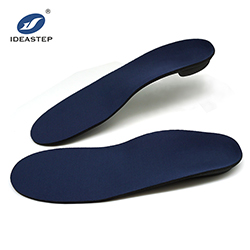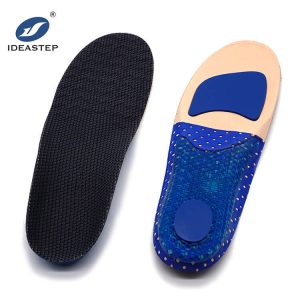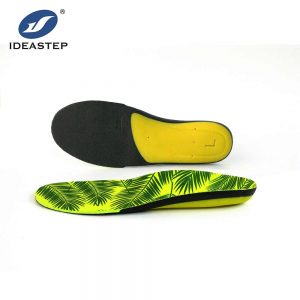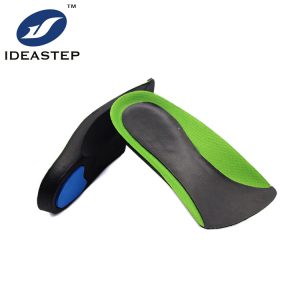According to the American Orthopaedic Foot and Ankle Society research report, women suffer from foot pain about 9 times as many as men, and the main reason is that they wear the wrong shoes. Wearing the wrong shoes, in addition to the shoes that don’t fit the feet, part of the reason is that we use the wrong insoles, causing the wrong foot and the ground to focus on, causing pain.
The total volume of the feet accounts for less than 5% of the body, but when we walk, our feet have to bear 1.5 times the weight of our body, and also shoulder the work of pushing the body forward; when running and jumping, it increases to 2 to 3 times or even 4 to 4.5 times. Therefore, once wearing shoes that do not fit your feet, it is not only easy to cause injury to the feet, it may even affect the chain reaction of knee joints, hip joints, or lower back pain.
Soft insoles cannot solve “plantar pain”
Many women think that soft insoles can relieve plantar pain. This is a wrong concept. On the contrary, it will cause uneven pressure and worsen pain due to insufficient support. In addition, if the shoe last is small, the toe is not stretched enough. The claw-like toe will increase the pressure on the metatarsal bones and make the metatarsal pain worse. In this situation, you should consult a professional foot and ankle surgeon or physical therapist to properly protect your feet and avoid secondary injuries.
When wearing high heels, you can place insoles on the forefoot metatarsals, arches, and back heels to disperse the pressure.
The American Academy of Foot Medicine (APMA) reminds us that to prevent the tragedies of the foot, ankle, and knee injuries, you need to wear shoes suitable for this sport when you are engaged in various sports, such as walking shoes for walking, and basketball shoes for playing basketball.
In addition, special attention should be paid to whether the midline of the shoe is perpendicular to the ground, and the heel guard should be hard to protect the ankle, plus an air cushion to help cushion and absorb shocks. This is the most basic principle of shoe selection.

The insole of sports shoes is very important
Air cushions also have different degrees of softness and hardness. Too hard insoles cannot be adjusted according to the shape of the foot when walking. The feet need to use more strength to resist the pressure. Wearing for a long time will make the arches tight and increase the burden on the feet. But too soft insoles worry about insufficient support and stability, and cannot effectively share the pressure of the foot. Therefore, when trying on it, it is best to see if it is too hard, or soft enough that the feet feel like sinking, to judge whether the hardness is moderate.
In addition, you can also choose an insole with a slightly raised design at the arch of the foot. The arch of the foot is supported, which may reduce the soreness of the inner shin of the calf after exercise.
Many people have a bad habit of putting on sneakers directly or stepping on their heels as casual shoes. Don’t! In this way, the heel protector is easy to deform and loses the function of protecting and stabilizing the ankle.

Arch pads are not a panacea for flat feet
There are many reasons for flat feet, and not every condition is suitable for arch pads. Forefoot varus can also cause flat feet, but for such patients, the arch pad may temporarily relieve the discomfort. After long-term use, it may cause the plantar fascia to stretch and tighten for a long time, and cause the plantar fascia. Inflammation, pain, etc. Faced with this situation, the easiest way is to put a footpad on the big toe to give a support point, and the problem is solved.
However, because of the cause and severity of flat feet, it is difficult for us to judge by ourselves. We still need to find a specialist doctor or physical therapist to receive the correct treatment to prevent the pain from getting worse. If the pain is still not relieved after putting on the insole, it is necessary to discard the insole as soon as possible and seek an expert to find out the problem as soon as possible.

Small insole Big Knowledge
Most of the common insoles on the market can only temporarily relieve pain, or only have general health care functions. Special foot conditions may still have to be evaluated and judged by a specialist or physical therapist for treatment or correction.
Of course, the insoles also have a life span and need to be maintained. In addition to cleaning, silicone pads are soft materials that will harden if exposed to the sun, destroying the shock-absorbing function, so be careful.
In addition, many people have a myth that the more expensive the insole, the better, but Chai Huimin reminds us that it is still important to find a suitable insole based on personal circumstances; and once the insole is added, it will hurt and must be replaced immediately.

5 minutes to exercise
First, relax your feet, and then curl your toes downwards. This can exercise the contortions of tendons and prevent the metatarsals from exposing and causing “metatarsalgia.” Finally, push the toes upwards and stretch them to exercise the abduction and extensor tendons to avoid the hallux. Toe valgus. If you can’t easily do these actions, it means that you already have an imbalance between the internal and external muscles of your feet; but don’t worry too much, it’s not too late to start practicing now.
